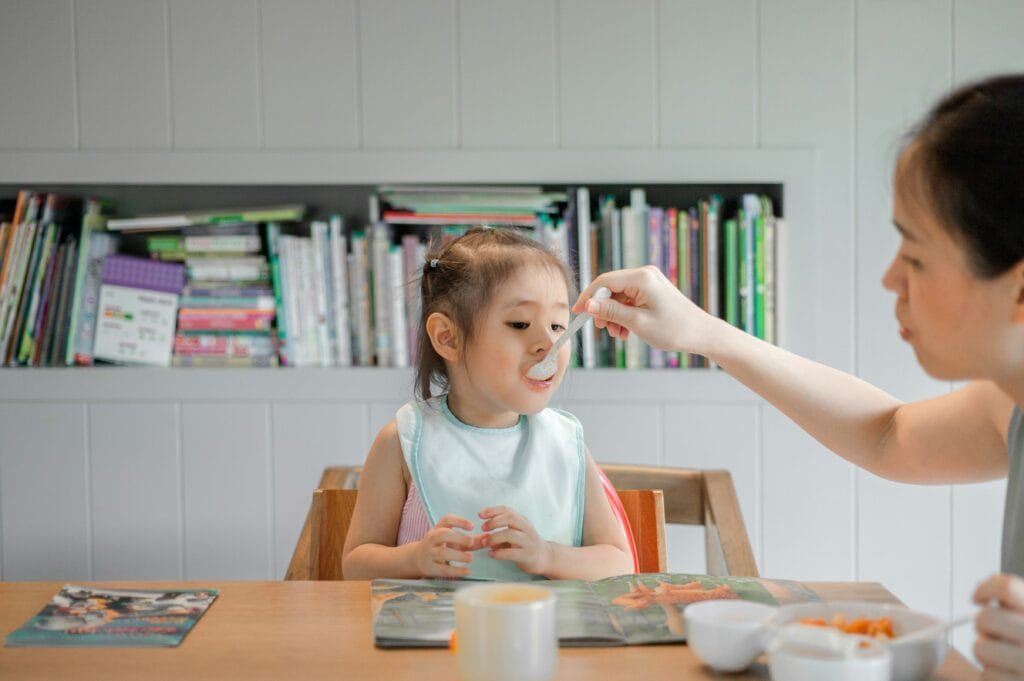Mindful parenting transforms ordinary moments into meaningful connections. Research by the Mindfulness Research Center shows that parents who practice mindfulness report 23% less stress and 31% better communication with their children. These exercises create calm, connected families through simple daily practices.
1. Morning Gratitude Circle
A gratitude practice sets a positive foundation for the entire day. Gather in a circle before breakfast or during the morning routine.
How to practice:
- Sit together in a comfortable position
- Each person shares one gratitude
- Practice active listening without interrupting
- End with a group hug or high-five
“Gratitude is the memory of the heart” – Jean Baptiste Massieu
Troubleshooting:
- If children resist – Start with sharing your own gratitudes and invite them to join when ready
- For busy mornings – Do this during breakfast or car rides
- For different age groups – Let younger children draw their gratitudes
Inner critic says: “This is too time-consuming and unrealistic.”
Reality check: Regular gratitude practice reduces childhood anxiety by 40% according to child psychology studies.
2. Mindful Listening Practice
Deep listening builds trust and emotional security. This practice helps children feel valued and understood.
Key elements:
- Stop all activities when your child speaks
- Make eye contact at their level
- Ask clarifying questions
- Reflect back what you heard
“Listening is an act of love” – Dave Isay
Troubleshooting:
- For distracted children – Use a “talking stick” or special object
- For multiple children – Set individual listening time for each child
- For busy parents – Schedule 10-minute dedicated listening sessions
Research fact: Children who experience mindful listening show 28% improvement in emotional regulation.

3. Breathing Buddies Exercise
This playful breathing practice makes meditation accessible for children.
Steps:
- Choose a favorite stuffed animal
- Lie down in a quiet space
- Place the “buddy” on your bellies
- Watch it rise and fall
- Practice for 2-5 minutes
Troubleshooting:
- If children get silly – Join their laughter, then gently guide back to breath
- For fidgety kids – Start with 30 seconds and gradually increase
- For resistance – Let them choose when to practice
4. Emotion Weather Report
Building emotional intelligence through weather metaphors makes feelings accessible.
Weather codes:
- Sunny – Happy, peaceful
- Cloudy – Confused, unsure
- Rainy – Sad, disappointed
- Stormy – Angry, frustrated
- Rainbow – Hopeful, transitioning
“Feelings are much like waves, we can’t stop them from coming but we can choose which ones to surf” – Jonatan Martensson
Troubleshooting:
- For reluctant sharers – Start with your own weather report
- For intense emotions – Add “weather forecast” to discuss future feelings
- For young children – Use weather pictures or drawings

5. Three Breaths Reset
This quick technique prevents emotional escalation and builds co-regulation skills.
How to practice:
- First breath – Notice feelings
- Second breath – Release tension
- Third breath – Choose response
Research shows: Three deep breaths reduce cortisol levels by 11% within minutes.
Troubleshooting:
- During tantrums – Model the breathing yourself first
- For resistance – Make it playful with animal breaths
- For older kids – Let them customize their breathing pattern
“Between stimulus and response there is a space. In that space is our power to choose our response” – Viktor Frankl
6. Bedtime Body Scan
Creates peaceful transitions to sleep while teaching body awareness.
Sequence:
- Start at toes
- Move up slowly
- Use gentle imagery
- End with whole-body relaxation
Troubleshooting:
- For energetic children – Add progressive muscle tension/release
- For scared children – Include protective imagery
- For rushing children – Start with mini-scans of just hands or feet
7. Mindful Walking Together
While walking with your child, notice things around you. Ask what sounds they hear, what colours they see, and what they feel beneath their feet. This will build their sensory awareness and presence.
Inner critic says: “This is too slow. We need to get where we’re going.”
Reality check: Mindful walks teach children to stay present and observe their environment.

8. Silent Signal System
A silent signal system creates intimate bonds and allows communication in any situation. Research shows that nonverbal communication makes up 65% of our daily interactions and strengthens emotional connection.
How to Create Your Signal System:
- Basic Connection Signals:
- “I love you” – Make a heart shape with your hands
- “Great job” – Quick double thumbs up
- “I’m proud of you” – Pat your heart twice
- “You’ve got this” – Fist pump with a wink
- “Need help?” – Gentle palm-up gesture
- “Take a breath” – Subtle finger to chest with calm inhale
- Emotional Support Signals:
- “Are you okay?” – Tilt head with concerned eyebrows
- “I’m here for you” – Cross arms over heart
- “Need space?” – Two hands making a “time out” shape
- “Feel better” – Gentle circular motion over the heart
- “I understand” – Simple head nod with soft smile
“Sometimes the most profound connections require no words at all” – Dr. Daniel Siegel
Practical Applications:
- During school performances
- In crowded public places
- Across the playground
- During family gatherings
- At sporting events
- In situations requiring quiet
Troubleshooting Common Challenges:
- For Forgotten Signals:
- Create a family signal book with drawings
- Practice signals during daily activities
- Take photos of each signal for reference
- Review signals during family meetings
- For Multiple Children:
- Create unique signals for each child
- Allow siblings to create special signals between themselves
- Use combination signals for group messages
- For Public Settings:
- Keep signals subtle and natural
- Practice appropriate timing
- Establish boundaries for usage
Inner critic says: “This seems silly and unnecessary when we can just talk.”
Reality check: Silent signals provide connection opportunities when verbal communication isn’t possible or appropriate.
Research Benefits:
- Builds nonverbal communication skills
- Creates special parent-child bonds
- Reduces public behavioural issues
- Supports emotional security
- Develops social awareness
- Enhances family unity
Expert Tips:
- Start with 3-4 basic signals
- Let children help create new signals
- Use signals consistently
- Make learning signals playful
- Respect when children don’t want to respond
“Nonverbal communication sets the tone of a relationship” – Dr. John Gottman
Advanced Signal Applications:
- Emergency Signals:
- “Need to leave” – Predetermined safety signal
- “Stay close” – Quick come-here gesture
- “Check in” – Eye contact with head tilt
- Celebration Signals:
- “Secret celebration” – Jazz hands at hip level
- “Proud moment” – Quick heart pat
- “Virtual high-five” – Subtle air five
- Comfort Signals:
- “Deep breath together” – Subtle chest tap
- “You’re safe” – Palm over heart
- “It’s okay” – Gentle okay sign
Integration Tips:
- Practice during calm moments
- Make it a fun family game
- Create signal stories
- Document signal successes
- Review and update signals monthly
“The strongest connections are often felt rather than heard” – Dr. Laura Markham
Remember: The goal is creating intimate connections, not replacing verbal communication. Signals should enhance, not substitute, regular communication patterns.
9. Mindful Meal Moments
Research shows that families who eat together mindfully 5+ times per week see a 40% improvement in children’s eating habits and experience 35% better family communication.

Core Practice Components:
Setting the Stage:
- Clear all devices from the table
- Turn off background noise
- Use simple table settings
- Light a non-scented candle (for older children)
- Set a pleasant atmosphere with soft lighting
Five Senses Food Exploration:
- Look – Notice food colours and arrangements
- Touch – Feel different textures safely
- Smell – Take in food aromas before eating
- Listen – Notice crunchy vs soft sounds
- Taste – Experience flavours mindfully
“When you eat with awareness, you feed your soul as well as your body” – Anne Lamott
Structured Mindful Eating Practice:
Beginning Ritual:
- Take three collective breaths
- Share one gratitude about the meal
- Notice steam rising from hot foods
- Observe food arrangement on plates
- Acknowledge the food’s journey to the table
During the Meal:
- Take smaller bites
- Put utensils down between bites
- Chew food completely
- Notice flavours changing
- Share food observations
Table Topics for Mindful Conversation:
- “What colours do you see on your plate?”
- “Which texture surprises you?”
- “What’s your favourite smell right now?”
- “How does the food change as you chew?”
- “What memories does this food bring up?”
Troubleshooting Common Challenges:
For Picky Eaters:
- Start with familiar foods
- Make texture exploration optional
- Celebrate small tries
- Allow gentle food play
- Focus on discovery, not pressure
For Rushed Meals:
- Set a minimum 15-minute meal time
- Use a gentle timer
- Plan meals at less busy times
- Prep food in advance
- Keep it simple
For Resistant Family Members:
- Start with one mindful minute
- Make it playful
- Allow natural conversation
- Lead by example
- Celebrate small wins
Inner critic says: “This is impossible with our busy schedule.”
Reality check: Research shows mindful meals actually reduce overall stress and improve time management.
Expert Tips:
- Start with one mindful meal per week
- Choose the least rushed meal
- Keep expectations realistic
- Make it age-appropriate
- Include meal preparation mindfulness
“Mindful eating is about presence, not perfection” – Dr. Susan Albers
Practical Implementation:
For Young Children (3-6):
- Use colour hunts on plates
- Play texture detective
- Make eating sounds fun
- Create simple food faces
- Use child-friendly terms
For School-Age Children (7-12):
- Explore food origins
- Discuss taste combinations
- Notice hunger/fullness signals
- Share food stories
- Practice basic cooking skills
For Teenagers:
- Discuss nutrition mindfully
- Explore cultural food connections
- Share meal planning
- Practice cooking together
- Respect food preferences
Research Benefits:
- Better digestion
- Improved portion control
- Enhanced taste awareness
- Reduced eating conflicts
- Stronger family bonds
- Better nutrition choices
“The family that eats together, grows together” – Unknown
Start with one mindful family meal this week. Focus on being present and enjoying the experience together. Notice how this small change affects your family’s connection and communication.
Remember: Perfect mindful meals don’t exist. Each attempt builds awareness and strengthens family bonds.
Implementation Tips
- Start with one exercise that resonates most
- Practice consistently for 21 days
- Adjust timing to your family schedule
- Celebrate small successes
- Be patient with the process
“The small things? The small moments? They aren’t small” – Jon Kabat-Zinn
Your Next Steps to Mindful Parenting
Transform your parenting journey with personalized guidance. Book a one-on-one consultation to:
- Create a custom mindfulness routine
- Address specific parenting challenges
- Learn advanced techniques
- Receive ongoing support
Schedule your consultation now:
Begin your mindful parenting journey today. Your family deserves this gift of presence and connection.
Inner critic says: “You should be able to figure this out on your own.”
Reality check: Even mindfulness teachers have mentors. Support accelerates growth and ensures sustainable practice.




